-
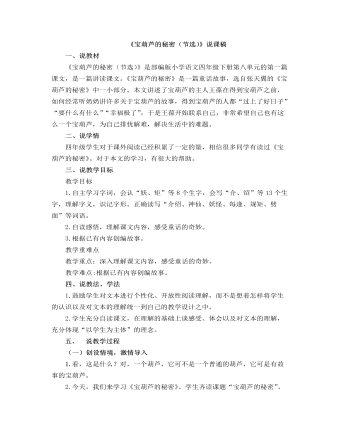
部编人教版四年级下册《 宝葫芦的秘密(节选)》说课稿
三、说教学目标教学目标1.自主学习字词,会认“妖、矩”等8个生字,会写“介、绍”等13个生字,理解字义,识记字形。正确读写“介绍、神仙、妖怪、每逢、规矩、劈面”等词语。2.自读感悟,理解课文内容,感受童话的奇妙。3.根据已有内容创编故事。教学重难点教学重点:深入理解课文内容,感受童话的奇妙。教学难点:根据已有内容创编故事。四、说教法、学法1.鼓励学生对文本进行个性化、开放性阅读理解,而不是想着怎样将学生的认识以及对文本的理解统一到自己的教学设计之中。2.学生充分自读课文,在理解的基础上谈感受、体会以及对文本的理解,充分体现“以学生为主体”的理念。
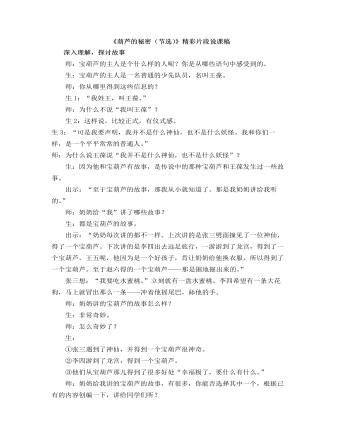
部编人教版四年级下册《 宝葫芦的秘密(节选)》精彩片段说课稿
深入理解,探讨故事师:宝葫芦的主人是个什么样的人呢?你是从哪些语句中感受到的。生:宝葫芦的主人是一名普通的少先队员,名叫王葆。师:你从哪里得到这些信息的?生1:“我姓王,叫王葆。”师:为什么不说“我叫王葆”?生2:这样说,比较正式,有仪式感。生3:“可是我要声明,我并不是什么神仙,也不是什么妖怪。我和你们一样,是一个平平常常的普通人。”师:为什么说王葆说“我并不是什么神仙,也不是什么妖怪”?生:因为他和宝葫芦有故事,是传说中的那种宝葫芦和王葆发生过一些故事。出示:“至于宝葫芦的故事,那我从小就知道了。那是我奶奶讲给我听的。”师:奶奶给“我”讲了哪些故事?
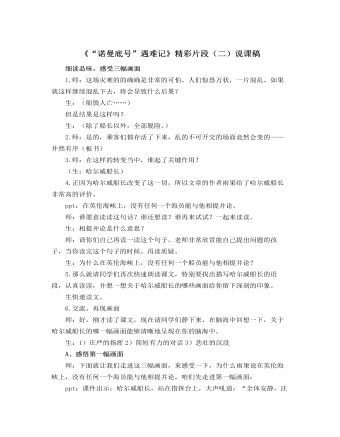
部编人教版四年级下册《 “诺曼底号”遇难记》精彩片段(二)说课稿
师:对,镇定自若。(板书:镇定自若)这份镇定自若,别人能与他相提并论吗?(不能)4.你还能从这段话中读出什么来?妇女先走,船员断后。咱们常说女士优先,在灾难面前也做到让妇女先走,这叫什么?生:绅士风度。(板书:绅士风度)5.同学们,假如你就是哈尔威船长,面对混乱的人群,你准备怎样来下达这道命令?指名学生朗读。(师指导:场面混乱,情况危急。)师:在灾难面前,时间就是生命。师:这是庄严的指挥,这是威严的指挥。我们一起来读读。师:真好,读得好,脸部的表情也非常到位,满脸的威严,正因为这样,所以课文的作者雨果是这样评价船长的,再读。ppt:在英伦海峡上,没有任何一个海员能与他相提并论。(生齐读)师:不能与他相提并论的还有他的:忠于职守、镇定自若、绅士风度。这是咱们从第一幅画面中感受到的。
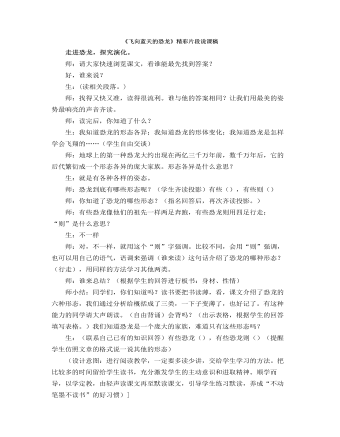
部编人教版四年级下册《 飞向蓝天的恐龙》精彩片段说课稿
师:是呀。早在19世纪,英国学者赫胥黎就注意到恐龙和鸟类在骨骼结构上有许多相似之处。在研究了大量恐龙与鸟类化石之后,科学家们提出,鸟类不仅和恐龙有亲缘关系,而且很可能就是一种小型恐龙的后裔。但相关化石一直没有找到。直到20世纪末期生:在课文中找出相关段落齐读。师:(投影出示再读)你读懂了什么?生:我知道了化石是首次发现,是在辽西发现……(学生交流)师:欣喜若狂,是什么意思?生:高兴到了极点,就要发狂了。师:研究者们为什么会如此地高兴?(设计意图:由点带面,通过重点词语的理解,感受科学家的艰辛与执着。)
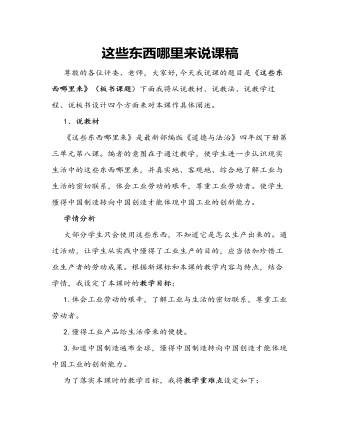
人教部编版道德与法制四年级下册这些东西哪里来说课稿
用扇子扇风乘凉→空调乘凉问题:你能发现洗衣机,电梯,空调等产品的诞生,帮助人们解决了什么问题吗?小调查。问一问家人,他们小时候用的物品,哪些现在已经不生产了?哪些物品是过去没有,而现在有的,给我们生活带来了哪些舒适和便利?(三)想一想:从人们的生活需要出发,我们还可以改善和发明哪些产品?我的设想:【设计理念】通过这些活动环节,让学生从实践中懂得了工业生产的目的。我们应当倍加珍惜工业生产者的劳动成果。活动三:从“中国制造”到“中国创造”看一看,查一查,说一说。1.观察各种商品,能否看到“中国制造”的商品。2.查一查:说说你了解的“中国创造”。3.区别一下:“中国制造”与“中国创造”。4.查找在世界上有影响的“中国创造”。
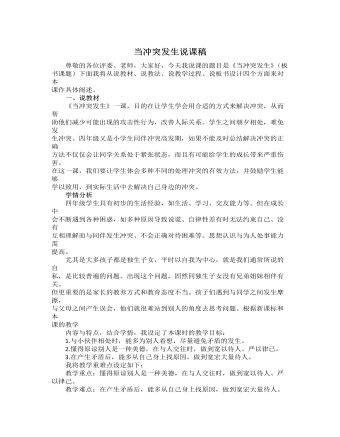
人教部编版道德与法制四年级下册当冲突发生说课稿
新课标要求:学生是学习和发展的主体;课程要通过创设多样性的情境不断丰富和提升学生的生活经验,引导学生自主学习和独立思考。教学中我主要通过学生参与式的教学模式,采取启发法、讨论法、探究法、情景法等教学方法,配合现代教学手段,使学生积极参与到教学活动中来。三、说教学过程(一)、导入课题1、观看表演《这不是我的纸屑》2、交流:说说你对这个情节中两位同学的看法。3、揭示课题:(二)、寻找冲突原因1、指名交流:说说你与同学的一次冲突事件。(随机板书)2、交流与讨论:为什么会发生这样的冲突事件3、小组活动:针对以上冲突,结合同学发言,归纳冲突发生的原因。(三)、化解冲突1、学生交流:化解冲突活动的办法。2、板书总结办法。(四)、总结:懂得原谅别人是一种美德,在与人交往时,做到宽以待人、严以律己。在产生矛盾后,能多从自己身上找原因,做到宽宏大量待人。
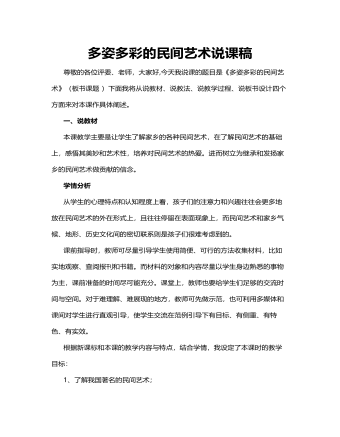
人教部编版道德与法制四年级下册多姿多彩的民间艺术说课稿
1、通过刚才的交流探讨,我们发现民间艺术源于生活,又高于生活,是先辈们用智慧和汗水创造出的“生活结晶”,代表着家乡人民的聪明智慧!2、那么,大家想亲自感受一下民间艺术的魅力吗?视频播放《土家摆手舞》,摆手舞是土家族古老的传统舞蹈,主要流传在鄂、湘、渝、黔交界的酉水河和乌江流域摆手舞是土家族古老的传统舞蹈,主要流传在鄂、湘、渝、黔交界的酉水河和乌江流域。3、小组活动,一起来学习一段土家摆手舞。4、通过大家刚才的体验,你能够猜一猜土家摆手舞的来源是什么吗?摆手舞反映土家人的生产生活。如狩猎舞表现狩猎活动和摹拟禽兽活动姿态。包括“赶猴子”、“拖野鸡尾巴”、“犀牛望月”、“磨鹰闪翅”、“跳蛤蟆”等十多个动作。有人说摆手舞起源于宗教祭祀活动。有人说是古代土家先民为了征服自然,抵抗外族入侵,便用一种“摆手”来健身壮骨,逐渐演变成后来的摆手舞。民间艺术满足了人们生产生活的多样需求,也能够表达人们的美好意愿,这是民间艺术产生的原因。

人教部编版道德与法制四年级下册合理消费说课稿
一、说教材(一)教材分析《合理消费》是最新部编版道德与法治四年级下册第二单元第五课的内容,本课内容主要讲述的是和我们生活密切相关的消费问题,通过学习已经感受到了我们的生活发生了日新月异的变化,我们小学生也有消费生活。因此,本节课是前面所学知识的自然延伸,也是前面所学内容的合理提升,与前面所学知识是有机联系的整体。(二)教学目标1.反思自己的消费行为,辨明自己需要和想要的东西。2.学会合理消费,养成勤俭节约的生活习惯和生活方式。(三)教学重难点教学重点:学会合理消费,养成勤俭节约的生活习惯和生活方式。教学难点:辨明自己需要和想要的东西,学会合理消费。二、说学情分析现在国富民强了,很多家庭都富裕了,对孩子的消费投入也增加了,孩子的要求他们一般都会满足。而许多学生往往会单纯的将消费与花钱划上等号,过早的把自己融入到享受消费、娱乐消费的人群中,“盲目消费”“攀比消费”等现象在小学生中并不少见,因此,让他们知道钱的来之不易是很有必要的。
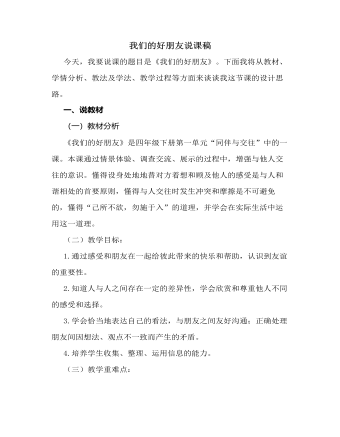
人教部编版道德与法制四年级下册我们的好朋友说课稿
教师:看呐,毛毛虫正在侵蚀着我们的友谊树,这些不利于友谊的行为我们统统拿掉。(摘掉友谊树上的毛毛虫卡片)教师:友谊树上终于结出了丰硕的果实。朋友之间,贵在理解,贵在沟通。只有这样,友谊之树才能茁壮成长。活动三:小小卡片传真情教师:朋友给予了我们那么多的帮助,带来那么多的快乐,你想对你的朋友说什么?请同学们把你想说的话填写在友谊卡片上。(学生制作卡并赠送卡片,采访收卡片同学。让学生认识什么是友谊,学会表达对同学的欣赏和友爱之情)教师:让我们再次对我们的好朋友说出那句真诚的话语,师生齐读:“我们的好朋友!”教师:《论语》“君子和而不同”,意思是君子在人际交往中,能够与他人保持一种和谐友善的关系,但在对具体问题的看法上却不必苟同于对方。人人都有自己的特点,不一样的朋友带给我们不一样的感受。希望同学们以后主动去结识更多的朋友,大家取长补短,共同进步。
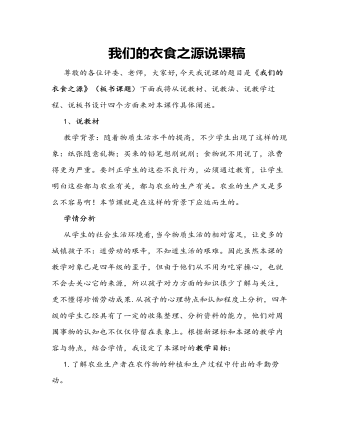
人教部编版道德与法制四年级下册我们的衣食之源说课稿
三、说教学过程(一)、视频、图片导入。1.师播“放白白的大米”视频及图片。生认真观察。师:视频和图片中是什么粮食?生:大米。师:对,是大米。大米可以做成香喷喷的米饭。当你吃着米饭的时侯,可曾想过,这白白的大米从哪里来的?今天,我们就来探究一下这个问题。2.板书课题:我们的衣食之源(二)、讲授新课。活动一:白白的大米哪里来看一看,说一说。1.看一看:继续播放大米生产过程视频。2.说一说:大米哪里来。育秧一一插秧一一田间管理一一收割一一碾米3.请选择一种农作物,可以是粮食作物,也可以是蔬菜,了解一下它的种植过程。【设计理念】通过观察和说一说,让学生对大米及其他农作物的种植过程加以了解,体会种田人的艰辛。

人教版新目标初中英语八年级上册How do you make a banana milk shake教案2篇
1. First, ... then, ... next, ... finally, ...首先,……然后,……接着,……最后,……这是英语中表达做某事的步骤的一种说法。如果步骤较多,还可以说:first-next-after that-later on-finally/at last通常你会听到说英语国家的人在说 first, next, then, finally 和后面的内容时,他们会做一些停顿。这样就能提前告诉听者接下来讲的是一系列的步骤。这一点在朗读和听力中应特别注意。2. how many, how much均为疑问词,同是“多少”,但用法不同。请看:how many修饰可数名词复数,how much修饰不可数名词。但在用法上,同学们常犯如下错误:1) [误] How many are there bananas on the table?[正] How many bananas are there on the table?[析] how many, how much 中的many,much是形容词,常修饰名词作定语,故后面跟名词。2) [误]How much tea are there on the table?[正]How much tea is there on the table?[析] how much修饰不可数名词时,谓语动词用单数。how many与how much的区别可简记为:前how many:问“多少”,复数名词后面跑;how much问“多少”,不可数名词单数好。前者答语用基数词,后者答语用数量关系。

人教版新目标初中英语八年级上册What are you doing for vacation教案2篇
Teaching goals : 1. Words & phrases: babysit ,get back , fishing , rent , think about , decide(on) , tourist etc. 2. How to talk about future plans . 3. 现在进行时表示将来计划或行动. 4. 特殊疑问句(where , when , how long引导) Important and difficult points : Drills :What are you doing for vacation ? I’m watching TV . When are you going ? I’m going … . How long are you staying ? We’re staying for five days . Teaching aids : cards and a tape ,a large wall calendar . Period 1 Teaching procedures : Step 1Leading in1. Free talk . 2. Put up the wall calendar . T: I’m staying home on Saturday (pointing to next Saturday ).Ss repeat . Ss: I’m staying home on Saturday . T: OK. Today we’ll learn how to talk about future plans. Step 2Pre-task SB Page 13 , 1a . 1. Look at the picture carefully and tell what you see in the picture . 2. Write the activities from the pictures in the box and add some more . 3. Practice reading . Step 3While-task1. Using the activities we write in 1a to make conversations .For example :What are you doing for vacation ? I’m visiting my uncle . 2. Pairwork .Practice in pairs . 3. 用第三人称练习对话.

人教版新目标初中英语八年级上册What’s the best radio station教案2篇
教学重点和难点:运用所掌握的语言描述,比较不同地点的特点。在练习中学习掌握英语比较级和最高级的用法。课前准备分配小组,每组五至六人。通过上网或翻阅报刊杂志等方法,确定旅游线路,做出基本的旅游计划。教学设计:本节课流程图 学法指导:1.由于这是一堂新课,在教学中应注意面向全体,发挥学生的主体性,引导学生积极参与,激发学生的求知欲和学习积极性,指导学生积极思维,主动获取知识,养成良好的学习方法。逐步学会独立解决问题。总之要尽可能调动学生的非智力因素促进智力因素的发展。教法选择:1.电化教学法2.课堂讨论法3.任务型教学法采用这些方法的目的是为了充分调动学生的学习积极性,使学生变被动学习为主动学习。通过电脑形象的演示,加强印象,提高兴趣,突破难点,提高教学效率,进而增大教学的容量和信息量。充分体现教师为主导,学生为主体的教学原则。

人教版新目标初中英语八年级上册How was your school trip教案2篇
“Go for it!” is based on “Task-Based Language Teaching”. It adheres to “The authenticity principle”, “The form-function principle”, “The task dependency principle” and “The principle of learning by doing”. These principles all accord with the demands of curriculum focus.In and of Grade Seven (II), “Go for it!”, students have learned “The Simple Past Tense”. And it appears again in of Grade Eight (I). teaches students more about how to talk about events in the past. In addition, it gives affirmative and negative statements in the past tense, such as the sentence patterns “Did you see …?” “Were there …?” “Did you go …?” As the first part of Unit 8, Section A opens with a picture presenting the last school trip in the aquarium and continues with several step-by-step practice activities, which are all good for students to master “The Simple Past Tense”. Doing well in Section A will help students integrate the new target language with that in Section B. Thus, they can describe the events in the past freely and foster their own ability of reflecting and practicing. II. Teaching ObjectivesTeaching objective is the beginning and aim of teaching activities. According to the overall goal of the English elementary course--- improve students' synthetic ability of language application, which should be based on the development of students’ “Language knowledge”, “Language skills”, “Character building”, “Learning strategies” and “Cross-cultural awareness”. The teaching objectives are described as follows(I). Knowledge objectivesi. Master the simple past tense of regular and irregular verbsii. Recite the new words and expressions about the last school trip in the aquarium, including their pronunciation and intonation

人教版新目标初中英语八年级上册How do you get to school教案2篇
Step Ⅶ Role play ( Work on 1b)1. First ask two students to read the dialogue to the class.Sa: How do you get to school?Sb: Well, I ride my bike to the subway station. Then I take the subway.2. Now work with a partner.Suppose you use two kinds of transportation to get to school \Hangzhou\Beijing... (bus, train, subway, walking, bike, etc.) Tell how you get there. You may use the phrases in 1a.3. Then ask different pairs of students to present their conversations to the class.Step ⅧListening1. Work on 2a(1) First ask students to read the list of information that Thomas wants to know.…where Nina lives.…how far from school she lives.…how long it takes to get to school.…how she gets to school.…what she thinks of the transportation.(2) Tell students what transportation and bus stop mean.bus stop 汽车站 transportation n. 运送;运输Then tell students we'll hear a recording. Please put a checkmark in front of each thing that Thomas wants to know.(3) Now play the recording for students.( Have students pay attention to the sample answer.) (4) Then correct the answers.

人教版新目标初中英语八年级上册I’m more outgoing than my sister教案2篇
1 交通工具的比较此活动为小组活动。学生通过讨论找出到达某一城市可乘坐的各种交通工具,并选择最佳出行方式。Teacher:We’re going to Shanghai. How many ways can we use to get there? Yes, there are four ways: by bus, by plane, by train, by ship. Please discuss how you are going to get there.操作建议:(1)学生以小组为单位展开活动,谈论本组所选择的交通工具。(2)各组选代表向全班汇报,阐述本组所选择的交通工具的利和弊。完成任务所需要的语言结构:We can go there by ship. It’s more comfortable and cheaper than any other transportation.We can go there by bus. It’s cheaper but it takes longer time.2 哪个城市更合适?此活动具有挑战性。假设中国要举行2014年世界杯足球赛,分别从历史,人文,天气等方面对各城市(北京,大连,上海,昆明)进行比较,选择最佳举办城市。T: Imagine China is holding the 2014 FIFA World Cup. Which city do you think is the best for the World Cup, Beijing, Dalian, Shanghai or Kunming? Let’s work in groups. If you choose Beijing, please join the Team Red. If you chose Dalian, please join the Team White. If you choose Shanghai, please join the Team Blue. If you choose Kunming, please join the Team Green. Please show us its advantages. Then let’s see which team will win.

人教版新目标初中英语八年级上册What’s the matter教案2篇
She shouldn’t go to the party tonight.Step7. TaskT: You know, there are lots of problems in our life. If you are a doctor, please tell us how to solve the problem. I will divide you into 9 groups. Please work in groups. And then choose one of you to report your ideas.The following are the problems:I have a toothache.I am hungry. I have a sore throat.I am stressed out. I have a sore back.I am tired. I can’t sleep.I have a cold. I have a headache.Report: If you have a headache, you should go to bed early. You should see the doctor. You should eat some medicine. You shouldn’t wash your face with cold water.You shouldn’t sleep late.You shouldn’t swim.…..T encourages the students to give advice as much as possible.Homework:1. Chose one of the problems, and write down your advice2. Copy the new words这一步是用于热身的,同时也可以让他们复习一部分的表示人体部位的单词,扩充知识.学习语言的过程也是一个不断积累的过程,复习旧知识,增添新知识.通过小游戏,强化学生对Does she/he have…这个句子的运用能力.通过复习,自然的引到下面新知识的学习。充分利用表格,由句子到对话,再到文章,让学生循序渐进. 提高学生的综合语言运用能力,运用以前学过的知识来解决身边的问题.Period 5 (Section B 3a—3c, selfcheck)教学内容与分析:

人教版新目标初中英语九年级上册Teenagers should be allowed to choose their own clothes教案2篇
Step 1 Greeting Greet the class and check the homeworkStep 2 A duty report The S on duty gives a report on the rules in his home and lead in 3a “Sun Fei’s and Wu Yu’s rules” Step 3 ReadingSs read the conversation and write the two girls’ rules in the chart. Check the answers.Get Ss to read after the tape and then read aloud by themselves. Then, T explains the language points.Step 4 Pairwork 3bRole play. Use the information in chart to practice with the conversation in 3a covered. They can look at the sample conversation in the right box.Step 5 Task 2 “Who’s the best reporter?”Make a survey by asking any 5 students the questions in the chart in activity 4. Then give out a report about it. See who is the best reporter? And the best reporter will get a nice ball-pen.Step 6 Summary and homework:Write out the report in your exercise-books.Period ThreeStep 1 Greeting and a duty reportThe S gives a duty report talking about his experience of being late for school. Lead in the question “Do you ever get to school late? How often do you get to school late? Always, usually, sometimes, or never?Step 2 1a Get Ss to finish writing.Step 3 Pairwork 1b Get Ss to talk about their answers with their partners using the sample conversation in the box on the right.Step 4 Listening practice2a Lead-in: What will happen if you get to school late? What about Peter? Let’s listen to a conversation between Peter and his father. Get Ss to finish 2a (As usual, for the first time, Ss only listen.) Check the answers.

人教版新目标初中英语九年级上册How do you study for a test教案2篇
内容提示本单元主要内容是学会利用verb十by/with gerund表示方式方法来讨论学习英语的策略,认识自己在学习方面的长处和不足。初步了解现在完成时的结构和用法。现在完成时由助动词have/has+动词的过去分词构成,主要表示过去发生的某一动作对现在仍有影响或造成的后果,常与already,yet,just,ever,never等副词连用。教学目标一、学习目标(Language Goal) 1. Talk about how to study . 学会讨论各种学习方法和策略。2. Find out your suitable learning methods. 找出适合自己的学习方法。 二、语言结构(Language Structures) 1. Verb + by with gerund by+动名词短语 表示“通过…途径,方法” 2. How questions have引导的特殊疑问句 三、目标语言(Target Language) 1. How do you study for tests ? 你是怎样准备考试的?Well , I study by working with my classmates. 哦,我和同学们一起学习。2. Have you ever studied with a group ? 你曾经参加过学习小组吗?Yes , I have . I’ve learned a lot that way . 是的,参加过。通过这种方式我学了许多。

人教版新目标初中英语九年级上册Where would you like to visit教案2篇
The First PeriodⅠ.Teaching Aims and DemandsKnowledge Objects(1) Key Vocabularytiring, educational, fascinating, thrilling, peaceful, exotic, trek, jungle, take it easy, explore, historic, site(2) Target LanguageWhere would you like to go on vacation?I’d like to trek through the jungle, because I like exciting vacations.2. Ability Objects(1)Train students to talk about places they would like to visit with the target language.(2)Train students to describe vacations with different adjectives.(3)Train students' listening skill.3. Moral Object,It′s more interesting to go on vacating somewhere instead of staying at home.Ⅱ. Teaching Key Points1. Key Vocabularytiring, educational, fascinating, thrilling, peaceful, exotic, trek, jungle, take it easy, explore, historic, site2. Target LanguageTalk about different places with the target language.Ⅲ. Teaching Difficult Points1. Describe vacations with different adjectives.2. Talk about different places with the target language.Ⅳ. Teaching Methods1. Teaching by illumination2. Teaching by doing chain drills3. Teaching by pairworkⅤ. Teaching Aids1. A tape recorder2. Some pictures of different places with famous views